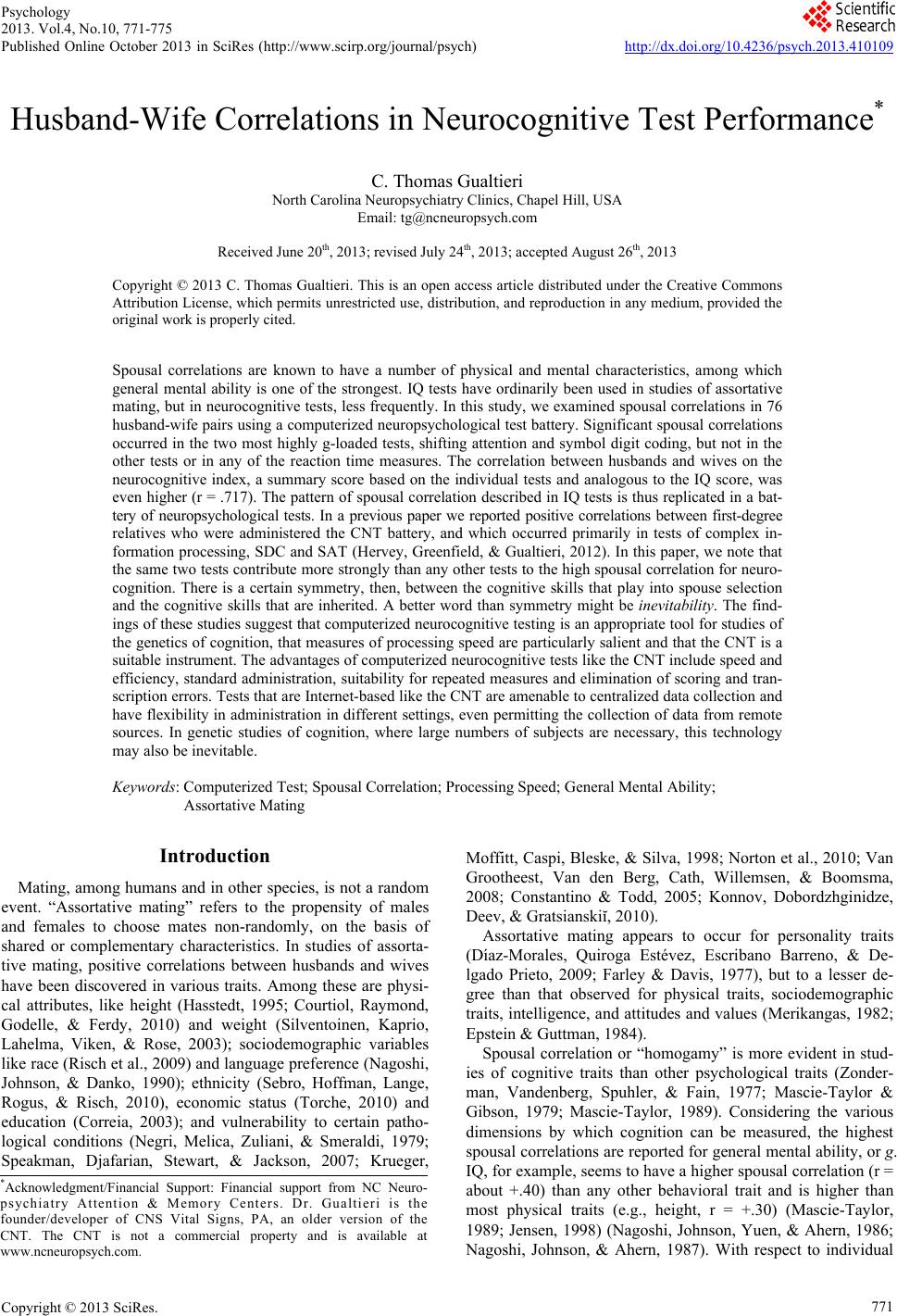 Psychology 2013. Vol.4, No.10, 771-775 Published Online October 2013 in SciRes (http://www.scirp.org/journal/psych) http://dx.doi.org/10.4236/psych.2013.410109 Copyright © 2013 SciRes. 771 Husband-Wife Correlations in Neurocognitive Test Performance* C. Thomas Gualtieri North Carolina Neuropsychiatry Clinics, Chapel Hill, USA Email: tg@ncneuropsych.com Received June 20th, 2013; revised July 24th, 2013; accepted August 26th, 2013 Copyright © 2013 C. Thomas Gualtieri. This is an open access article distributed under the Creative Commons Attribution License, which permits unrestricted use, distribution, and reproduction in any medium, provided the original work is properly cited. Spousal correlations are known to have a number of physical and mental characteristics, among which general mental ability is one of the strongest. IQ tests have ordinarily been used in studies of assortative mating, but in neurocognitive tests, less frequently. In this study, we examined spousal correlations in 76 husband-wife pairs using a computerized neuropsychological test battery. Significant spousal correlations occurred in the two most highly g-loaded tests, shifting attention and symbol digit coding, but not in the other tests or in any of the reaction time measures. The correlation between husbands and wives on the neurocognitive index, a summary score based on the individual tests and analogous to the IQ score, was even higher (r = .717). The pattern of spousal correlation described in IQ tests is thus replicated in a bat- tery of neuropsychological tests. In a previous paper we reported positive correlations between first-degree relatives who were administered the CNT battery, and which occurred primarily in tests of complex in- formation processing, SDC and SAT (Hervey, Greenfield, & Gualtieri, 2012). In this paper, we note that the same two tests contribute more strongly than any other tests to the high spousal correlation for neuro- cognition. There is a certain symmetry, then, between the cognitive skills that play into spouse selection and the cognitive skills that are inherited. A better word than symmetry might be inevitability. The find- ings of these studies suggest that computerized neurocognitive testing is an appropriate tool for studies of the genetics of cognition, that measures of processing speed are particularly salient and that the CNT is a suitable instrument. The advantages of computerized neurocognitive tests like the CNT include speed and efficiency, standard administration, suitability for repeated measures and elimination of scoring and tran- scription errors. Tests that are Internet-based like the CNT are amenable to centralized data collection and have flexibility in administration in different settings, even permitting the collection of data from remote sources. In genetic studies of cognition, where large numbers of subjects are necessary, this technology may also be inevitable. Keywords: Computerized Test; Spousal Correlation; Processing Speed; General Mental Ability; Assortative Mating Introduction Mating, among humans and in other species, is not a random event. “Assortative mating” refers to the propensity of males and females to choose mates non-randomly, on the basis of shared or complementary characteristics. In studies of assorta- tive mating, positive correlations between husbands and wives have been discovered in various traits. Among these are physi- cal attributes, like height (Hasstedt, 1995; Courtiol, Raymond, Godelle, & Ferdy, 2010) and weight (Silventoinen, Kaprio, Lahelma, Viken, & Rose, 2003); sociodemographic variables like race (Risch et al., 2009) and language preference (Nagoshi, Johnson, & Danko, 1990); ethnicity (Sebro, Hoffman, Lange, Rogus, & Risch, 2010), economic status (Torche, 2010) and education (Correia, 2003); and vulnerability to certain patho- logical conditions (Negri, Melica, Zuliani, & Smeraldi, 1979; Speakman, Djafarian, Stewart, & Jackson, 2007; Krueger, Moffitt, Caspi, Bleske, & Silva, 1998; Norton et al., 2010; Van Grootheest, Van den Berg, Cath, Willemsen, & Boomsma, 2008; Constantino & Todd, 2005; Konnov, Dobordzhginidze, Deev, & Gratsianskiĭ, 2010). Assortative mating appears to occur for personality traits (Díaz-Morales, Quiroga Estévez, Escribano Barreno, & De- lgado Prieto, 2009; Farley & Davis, 1977), but to a lesser de- gree than that observed for physical traits, sociodemographic traits, intelligence, and attitudes and values (Merikangas, 1982; Epstein & Guttman, 1984). Spousal correlation or “homogamy” is more evident in stud- ies of cognitive traits than other psychological traits (Zonder- man, Vandenberg, Spuhler, & Fain, 1977; Mascie-Taylor & Gibson, 1979; Mascie-Taylor, 1989). Considering the various dimensions by which cognition can be measured, the highest spousal correlations are reported for general mental ability, or g. IQ, for example, seems to have a higher spousal correlation (r = about +.40) than any other behavioral trait and is higher than most physical traits (e.g., height, r = +.30) (Mascie-Taylor, 1989; Jensen, 1998) (Nagoshi, Johnson, Yuen, & Ahern, 1986; Nagoshi, Johnson, & Ahern, 1987). With respect to individual *Acknowledgment/Financial Support: Financial support from NC Neuro- sychiatry Attention & Memory Centers. Dr. Gualtieri is the founder/developer of CNS Vital Signs, PA, an older version of the CNT. The CNT is not a commercial property and is available at www.ncneuropsych.com. 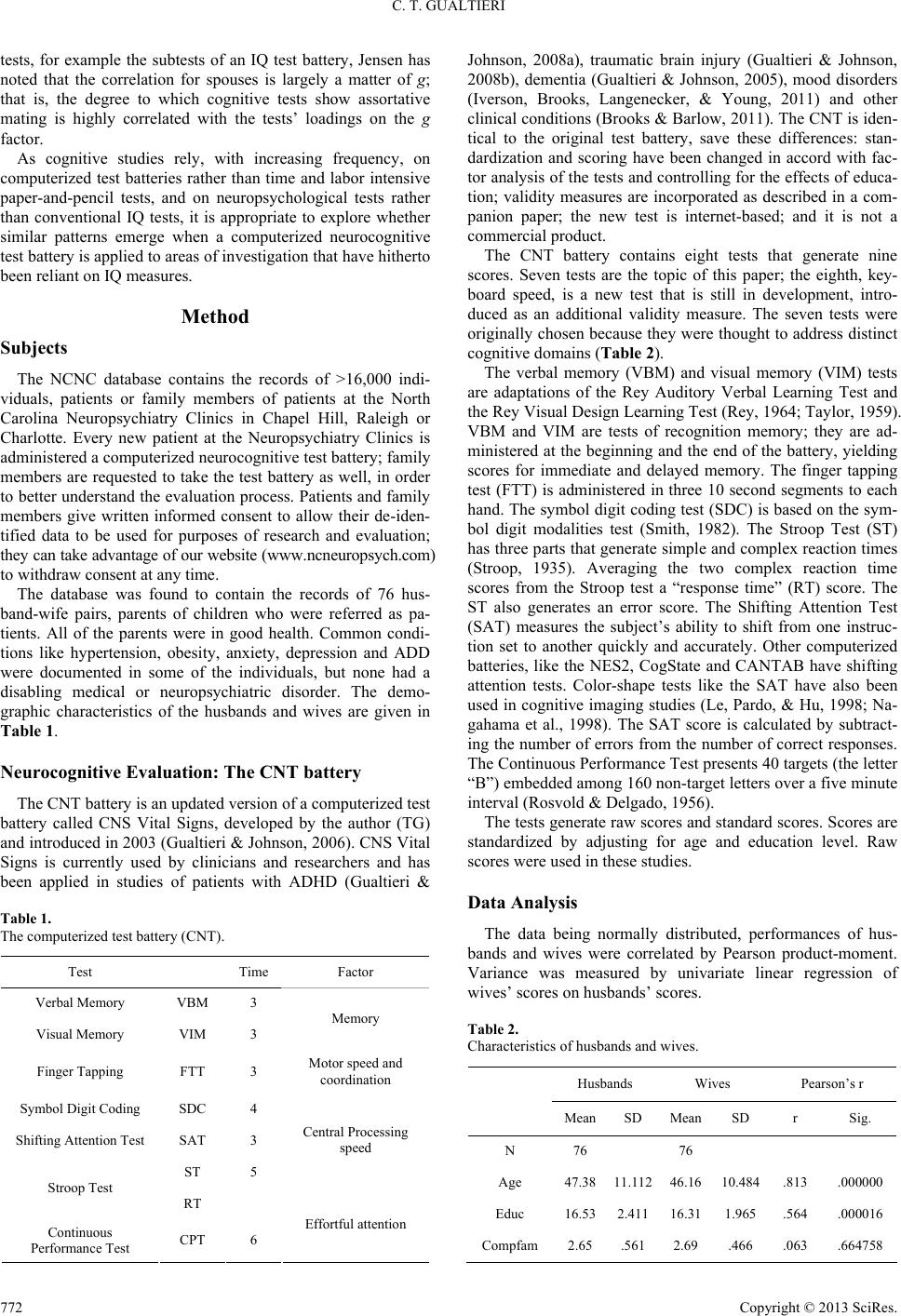 C. T. GUALTIERI tests, for example the subtests of an IQ test battery, Jensen has noted that the correlation for spouses is largely a matter of g; that is, the degree to which cognitive tests show assortative mating is highly correlated with the tests’ loadings on the g factor. As cognitive studies rely, with increasing frequency, on computerized test batteries rather than time and labor intensive paper-and-pencil tests, and on neuropsychological tests rather than conventional IQ tests, it is appropriate to explore whether similar patterns emerge when a computerized neurocognitive test battery is applied to areas of investigation that have hitherto been reliant on IQ measures. Method Subjects The NCNC database contains the records of >16,000 indi- viduals, patients or family members of patients at the North Carolina Neuropsychiatry Clinics in Chapel Hill, Raleigh or Charlotte. Every new patient at the Neuropsychiatry Clinics is administered a computerized neurocognitive test battery; family members are requested to take the test battery as well, in order to better understand the evaluation process. Patients and family members give written informed consent to allow their de-iden- tified data to be used for purposes of research and evaluation; they can take advantage of our website (www.ncneuropsych.com) to withdraw consent at any time. The database was found to contain the records of 76 hus- band-wife pairs, parents of children who were referred as pa- tients. All of the parents were in good health. Common condi- tions like hypertension, obesity, anxiety, depression and ADD were documented in some of the individuals, but none had a disabling medical or neuropsychiatric disorder. The demo- graphic characteristics of the husbands and wives are given in Table 1. Neurocognitive Evaluation: The CNT battery The CNT battery is an updated version of a computerized test battery called CNS Vital Signs, developed by the author (TG) and introduced in 2003 (Gualtieri & Johnson, 2006). CNS Vital Signs is currently used by clinicians and researchers and has been applied in studies of patients with ADHD (Gualtieri & Table 1. The computerized test battery (CNT). Test Time Factor Verbal Memory VBM 3 Visual Memory VIM 3 Memory Finger Tapping FTT 3 Motor speed and coordination Symbol Digit Coding SDC 4 Shifting Attention Test SAT 3 ST 5 Central Processing speed Stroop Test RT Continuous Performance Test CPT 6 Effortful attention Johnson, 2008a), traumatic brain injury (Gualtieri & Johnson, 2008b), dementia (Gualtieri & Johnson, 2005), mood disorders (Iverson, Brooks, Langenecker, & Young, 2011) and other clinical conditions (Brooks & Barlow, 2011). The CNT is iden- tical to the original test battery, save these differences: stan- dardization and scoring have been changed in accord with fac- tor analysis of the tests and controlling for the effects of educa- tion; validity measures are incorporated as described in a com- panion paper; the new test is internet-based; and it is not a commercial product. The CNT battery contains eight tests that generate nine scores. Seven tests are the topic of this paper; the eighth, key- board speed, is a new test that is still in development, intro- duced as an additional validity measure. The seven tests were originally chosen because they were thought to address distinct cognitive domains (Table 2). The verbal memory (VBM) and visual memory (VIM) tests are adaptations of the Rey Auditory Verbal Learning Test and the Rey Visual Design Learning Test (Rey, 1964; Taylor, 1959). VBM and VIM are tests of recognition memory; they are ad- ministered at the beginning and the end of the battery, yielding scores for immediate and delayed memory. The finger tapping test (FTT) is administered in three 10 second segments to each hand. The symbol digit coding test (SDC) is based on the sym- bol digit modalities test (Smith, 1982). The Stroop Test (ST) has three parts that generate simple and complex reaction times (Stroop, 1935). Averaging the two complex reaction time scores from the Stroop test a “response time” (RT) score. The ST also generates an error score. The Shifting Attention Test (SAT) measures the subject’s ability to shift from one instruc- tion set to another quickly and accurately. Other computerized batteries, like the NES2, CogState and CANTAB have shifting attention tests. Color-shape tests like the SAT have also been used in cognitive imaging studies (Le, Pardo, & Hu, 1998; Na- gahama et al., 1998). The SAT score is calculated by subtract- ing the number of errors from the number of correct responses. The Continuous Performance Test presents 40 targets (the letter “B”) embedded among 160 non-target letters over a five minute interval (Rosvold & Delgado, 1956). The tests generate raw scores and standard scores. Scores are standardized by adjusting for age and education level. Raw scores were used in these studies. Data Analysis The data being normally distributed, performances of hus- bands and wives were correlated by Pearson product-moment. Variance was measured by univariate linear regression of wives’ scores on husbands’ scores. Table 2. Characteristics of husbands and wives. Husbands Wives Pearson’s r Mean SD Mean SD r Sig. N 76 76 Age 47.3811.11246.16 10.484 .813 .000000 Educ 16.532.41116.31 1.965 .564 .000016 Compfam 2.65 .5612.69 .466 .063 .664758 Copyright © 2013 SciRes. 772 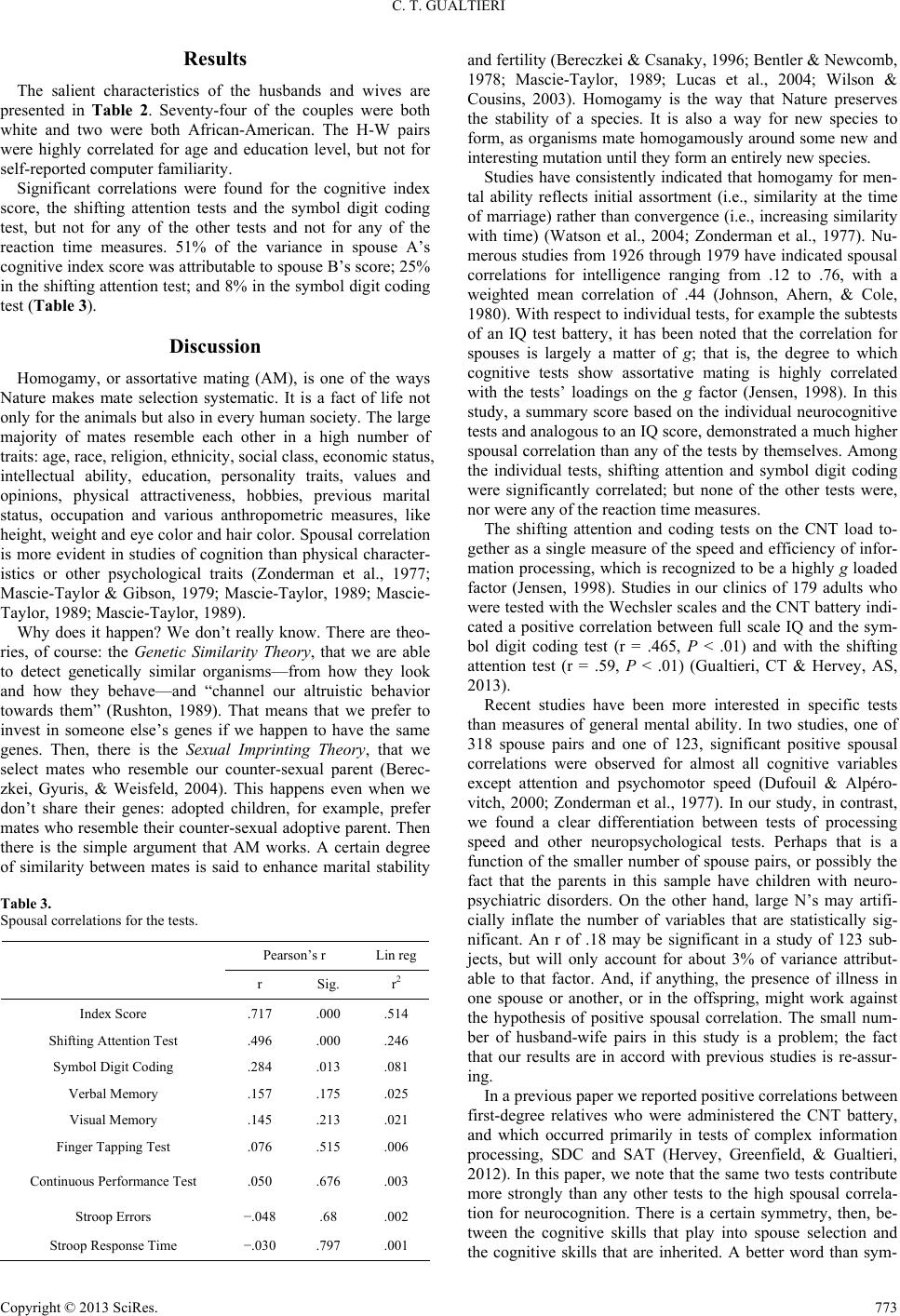 C. T. GUALTIERI Results The salient characteristics of the husbands and wives are presented in Table 2. Seventy-four of the couples were both white and two were both African-American. The H-W pairs were highly correlated for age and education level, but not for self-reported computer familiarity. Significant correlations were found for the cognitive index score, the shifting attention tests and the symbol digit coding test, but not for any of the other tests and not for any of the reaction time measures. 51% of the variance in spouse A’s cognitive index score was attributable to spouse B’s score; 25% in the shifting attention test; and 8% in the symbol digit coding test (Table 3). Discussion Homogamy, or assortative mating (AM), is one of the ways Nature makes mate selection systematic. It is a fact of life not only for the animals but also in every human society. The large majority of mates resemble each other in a high number of traits: age, race, religion, ethnicity, social class, economic status, intellectual ability, education, personality traits, values and opinions, physical attractiveness, hobbies, previous marital status, occupation and various anthropometric measures, like height, weight and eye color and hair color. Spousal correlation is more evident in studies of cognition than physical character- istics or other psychological traits (Zonderman et al., 1977; Mascie-Taylor & Gibson, 1979; Mascie-Taylor, 1989; Mascie- Taylor, 1989; Mascie-Taylor, 1989). Why does it happen? We don’t really know. There are theo- ries, of course: the Genetic Similarity Theory, that we are able to detect genetically similar organisms—from how they look and how they behave—and “channel our altruistic behavior towards them” (Rushton, 1989). That means that we prefer to invest in someone else’s genes if we happen to have the same genes. Then, there is the Sexual Imprinting Theory, that we select mates who resemble our counter-sexual parent (Berec- zkei, Gyuris, & Weisfeld, 2004). This happens even when we don’t share their genes: adopted children, for example, prefer mates who resemble their counter-sexual adoptive parent. Then there is the simple argument that AM works. A certain degree of similarity between mates is said to enhance marital stability Table 3. Spousal correlations for the tests. Pearson’s r Lin reg r Sig. r2 Index Score .717 .000 .514 Shifting Attention Test .496 .000 .246 Symbol Digit Coding .284 .013 .081 Verbal Memory .157 .175 .025 Visual Memory .145 .213 .021 Finger Tapping Test .076 .515 .006 Continuous Performance Test .050 .676 .003 Stroop Errors −.048 .68 .002 Stroop Response Time −.030 .797 .001 and fertility (Bereczkei & Csanaky, 1996; Bentler & Newcomb, 1978; Mascie-Taylor, 1989; Lucas et al., 2004; Wilson & Cousins, 2003). Homogamy is the way that Nature preserves the stability of a species. It is also a way for new species to form, as organisms mate homogamously around some new and interesting mutation until they form an entirely new species. Studies have consistently indicated that homogamy for men- tal ability reflects initial assortment (i.e., similarity at the time of marriage) rather than convergence (i.e., increasing similarity with time) (Watson et al., 2004; Zonderman et al., 1977). Nu- merous studies from 1926 through 1979 have indicated spousal correlations for intelligence ranging from .12 to .76, with a weighted mean correlation of .44 (Johnson, Ahern, & Cole, 1980). With respect to individual tests, for example the subtests of an IQ test battery, it has been noted that the correlation for spouses is largely a matter of g; that is, the degree to which cognitive tests show assortative mating is highly correlated with the tests’ loadings on the g factor (Jensen, 1998). In this study, a summary score based on the individual neurocognitive tests and analogous to an IQ score, demonstrated a much higher spousal correlation than any of the tests by themselves. Among the individual tests, shifting attention and symbol digit coding were significantly correlated; but none of the other tests were, nor were any of the reaction time measures. The shifting attention and coding tests on the CNT load to- gether as a single measure of the speed and efficiency of infor- mation processing, which is recognized to be a highly g loaded factor (Jensen, 1998). Studies in our clinics of 179 adults who were tested with the Wechsler scales and the CNT battery indi- cated a positive correlation between full scale IQ and the sym- bol digit coding test (r = .465, P < .01) and with the shifting attention test (r = .59, P < .01) (Gualtieri, CT & Hervey, AS, 2013). Recent studies have been more interested in specific tests than measures of general mental ability. In two studies, one of 318 spouse pairs and one of 123, significant positive spousal correlations were observed for almost all cognitive variables except attention and psychomotor speed (Dufouil & Alpéro- vitch, 2000; Zonderman et al., 1977). In our study, in contrast, we found a clear differentiation between tests of processing speed and other neuropsychological tests. Perhaps that is a function of the smaller number of spouse pairs, or possibly the fact that the parents in this sample have children with neuro- psychiatric disorders. On the other hand, large N’s may artifi- cially inflate the number of variables that are statistically sig- nificant. An r of .18 may be significant in a study of 123 sub- jects, but will only account for about 3% of variance attribut- able to that factor. And, if anything, the presence of illness in one spouse or another, or in the offspring, might work against the hypothesis of positive spousal correlation. The small num- ber of husband-wife pairs in this study is a problem; the fact that our results are in accord with previous studies is re-assur- ing. In a previous paper we reported positive correlations between first-degree relatives who were administered the CNT battery, and which occurred primarily in tests of complex information processing, SDC and SAT (Hervey, Greenfield, & Gualtieri, 2012). In this paper, we note that the same two tests contribute more strongly than any other tests to the high spousal correla- tion for neurocognition. There is a certain symmetry, then, be- tween the cognitive skills that play into spouse selection and the cognitive skills that are inherited. A better word than sym- Copyright © 2013 SciRes. 773 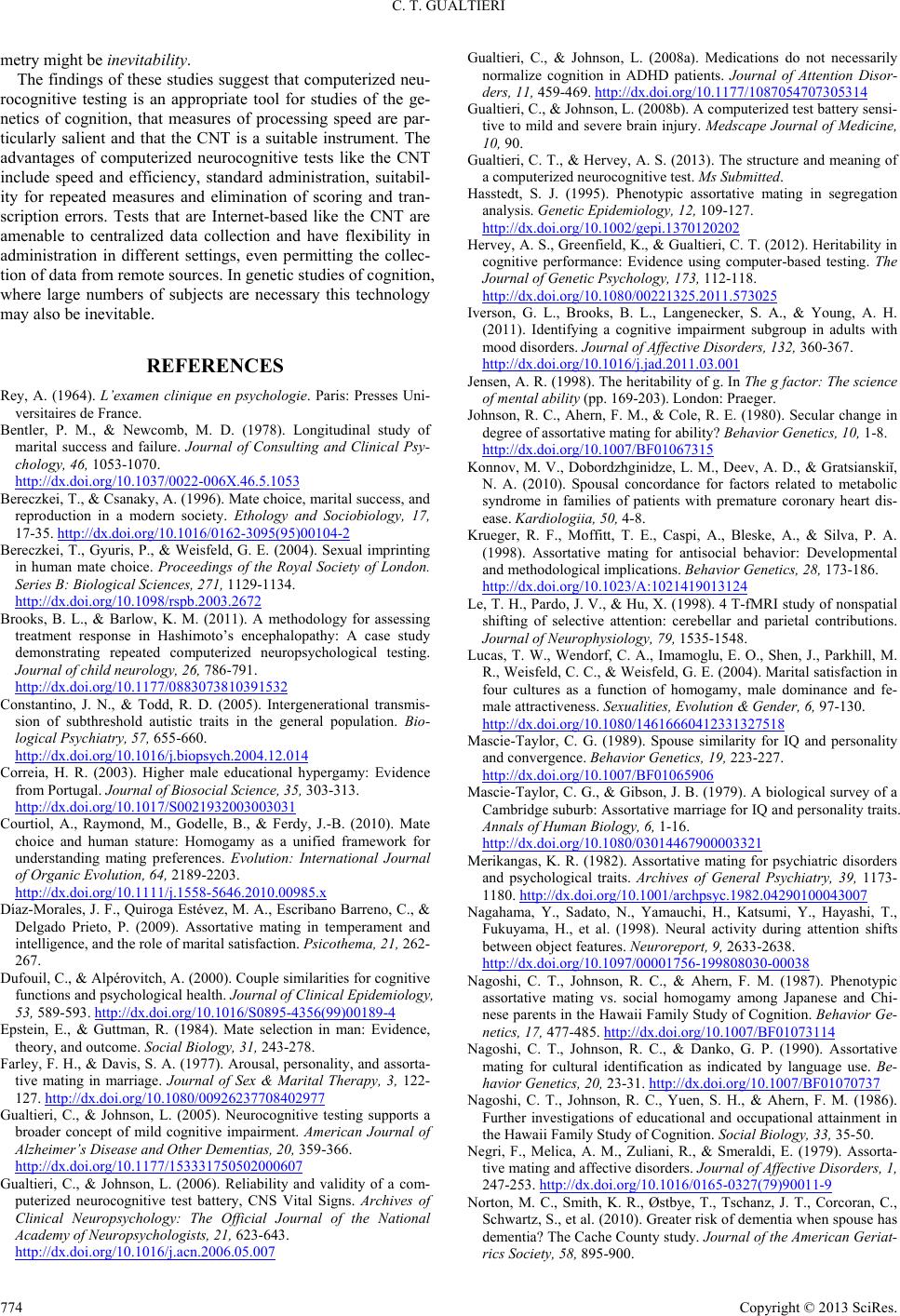 C. T. GUALTIERI metry might be inevitability. The findings of these studies suggest that computerized neu- rocognitive testing is an appropriate tool for studies of the ge- netics of cognition, that measures of processing speed are par- ticularly salient and that the CNT is a suitable instrument. The advantages of computerized neurocognitive tests like the CNT include speed and efficiency, standard administration, suitabil- ity for repeated measures and elimination of scoring and tran- scription errors. Tests that are Internet-based like the CNT are amenable to centralized data collection and have flexibility in administration in different settings, even permitting the collec- tion of data from remote sources. In genetic studies of cognition, where large numbers of subjects are necessary this technology may also be inevitable. REFERENCES Rey, A. (1964). L’examen clinique en psychologie. Paris: Presses Uni- versitaires de France. Bentler, P. M., & Newcomb, M. D. (1978). Longitudinal study of marital success and failure. Journal of Consulting and Clinical Psy- chology, 46, 1053-1070. http://dx.doi.org/10.1037/0022-006X.46.5.1053 Bereczkei, T., & Csanaky, A. (1996). Mate choice, marital success, and reproduction in a modern society. Ethology and Sociobiology, 17, 17-35. http://dx.doi.org/10.1016/0162-3095(95)00104-2 Bereczkei, T., Gyuris, P., & Weisfeld, G. E. (2004). Sexual imprinting in human mate choice. Proceedings of the Royal Society of London. Series B: Biological Scie n c es, 271, 1129-1134. http://dx.doi.org/10.1098/rspb.2003.2672 Brooks, B. L., & Barlow, K. M. (2011). A methodology for assessing treatment response in Hashimoto’s encephalopathy: A case study demonstrating repeated computerized neuropsychological testing. Journal of child neurology, 26, 786-791. http://dx.doi.org/10.1177/0883073810391532 Constantino, J. N., & Todd, R. D. (2005). Intergenerational transmis- sion of subthreshold autistic traits in the general population. Bio- logical Psychiatry, 57, 655-660. http://dx.doi.org/10.1016/j.biopsych.2004.12.014 Correia, H. R. (2003). Higher male educational hypergamy: Evidence from Portugal. Journal o f Biosocial Science, 35 , 303-313. http://dx.doi.org/10.1017/S0021932003003031 Courtiol, A., Raymond, M., Godelle, B., & Ferdy, J.-B. (2010). Mate choice and human stature: Homogamy as a unified framework for understanding mating preferences. Evolution: International Journal of Organic Evolution, 64, 2189-2203. http://dx.doi.org/10.1111/j.1558-5646.2010.00985.x Díaz-Morales, J. F., Quiroga Estévez, M. A., Escribano Barreno, C., & Delgado Prieto, P. (2009). Assortative mating in temperament and intelligence, and the role of marital satisfaction. Psicothema, 21, 262- 267. Dufouil, C., & Alpérovitch, A. (2000). Couple similarities for cognitive functions and psychological health. Journal of Clinical Epidemiology, 53, 589-593. http://dx.doi.org/10.1016/S0895-4356(99)00189-4 Epstein, E., & Guttman, R. (1984). Mate selection in man: Evidence, theory, and outcome. Social Biology, 31, 243-278. Farley, F. H., & Davis, S. A. (1977). Arousal, personality, and assorta- tive mating in marriage. Journal of Sex & Marital Therapy, 3, 122- 127. http://dx.doi.org/10.1080/00926237708402977 Gualtieri, C., & Johnson, L. (2005). Neurocognitive testing supports a broader concept of mild cognitive impairment. American Journal of Alzheimer’s Disease and Other D e mentias, 20, 359-366. http://dx.doi.org/10.1177/153331750502000607 Gualtieri, C., & Johnson, L. (2006). Reliability and validity of a com- puterized neurocognitive test battery, CNS Vital Signs. Archives of Clinical Neuropsychology: The Official Journal of the National Academy of Neuropsychologists, 21, 623-643. http://dx.doi.org/10.1016/j.acn.2006.05.007 Gualtieri, C., & Johnson, L. (2008a). Medications do not necessarily normalize cognition in ADHD patients. Journal of Attention Disor- ders, 11, 459-469. http://dx.doi.org/10.1177/1087054707305314 Gualtieri, C., & Johnson, L. (2008b). A computerized test battery sensi- tive to mild and severe brain injury. Medscape Journal of Medicine, 10, 90. Gualtieri, C. T., & Hervey, A. S. (2013). The structure and meaning of a computerized neurocognitive test. Ms Submitted. Hasstedt, S. J. (1995). Phenotypic assortative mating in segregation analysis. Genetic Epidemiology, 12, 109-127. http://dx.doi.org/10.1002/gepi.1370120202 Hervey, A. S., Greenfield, K., & Gualtieri, C. T. (2012). Heritability in cognitive performance: Evidence using computer-based testing. The Journal of Genetic Psychology, 173 , 112-118. http://dx.doi.org/10.1080/00221325.2011.573025 Iverson, G. L., Brooks, B. L., Langenecker, S. A., & Young, A. H. (2011). Identifying a cognitive impairment subgroup in adults with mood disorders. Journal of Affective Disorders, 132, 360-367. http://dx.doi.org/10.1016/j.jad.2011.03.001 Jensen, A. R. (1998). The heritability of g. In The g factor: The science of mental ability (pp. 169-203). London: Praeger. Johnson, R. C., Ahern, F. M., & Cole, R. E. (1980). Secular change in degree of assortative mating for ability? Behavior Genetics, 10, 1-8. http://dx.doi.org/10.1007/BF01067315 Konnov, M. V., Dobordzhginidze, L. M., Deev, A. D., & Gratsianskiĭ, N. A. (2010). Spousal concordance for factors related to metabolic syndrome in families of patients with premature coronary heart dis- ease. Kardiologiia, 50, 4-8. Krueger, R. F., Moffitt, T. E., Caspi, A., Bleske, A., & Silva, P. A. (1998). Assortative mating for antisocial behavior: Developmental and methodological implications. Behavior Genetics, 28, 173-186. http://dx.doi.org/10.1023/A:1021419013124 Le, T. H., Pardo, J. V., & Hu, X. (1998). 4 T-fMRI study of nonspatial shifting of selective attention: cerebellar and parietal contributions. Journal of Neurophysiology, 79, 1535-1548. Lucas, T. W., Wendorf, C. A., Imamoglu, E. O., Shen, J., Parkhill, M. R., Weisfeld, C. C., & Weisfeld, G. E. (2004). Marital satisfaction in four cultures as a function of homogamy, male dominance and fe- male attractiveness. Sexuali ties, Evolution & Gende r, 6, 97-130. http://dx.doi.org/10.1080/14616660412331327518 Mascie-Taylor, C. G. (1989). Spouse similarity for IQ and personality and convergence. Behav i or G e ne ti cs , 1 9, 223-227. http://dx.doi.org/10.1007/BF01065906 Mascie-Taylor, C. G., & Gibson, J. B. (1979). A biological survey of a Cambridge suburb: Assortative marriage for IQ and personality traits. Annals of Human Biology, 6, 1-16. http://dx.doi.org/10.1080/03014467900003321 Merikangas, K. R. (1982). Assortative mating for psychiatric disorders and psychological traits. Archives of General Psychiatry, 39, 1173- 1180. http://dx.doi.org/10.1001/archpsyc.1982.04290100043007 Nagahama, Y., Sadato, N., Yamauchi, H., Katsumi, Y., Hayashi, T., Fukuyama, H., et al. (1998). Neural activity during attention shifts between object features. Neuroreport, 9, 2633-2638. http://dx.doi.org/10.1097/00001756-199808030-00038 Nagoshi, C. T., Johnson, R. C., & Ahern, F. M. (1987). Phenotypic assortative mating vs. social homogamy among Japanese and Chi- nese parents in the Hawaii Family Study of Cognition. Behavior Ge- netics, 17, 477-485. http://dx.doi.org/10.1007/BF01073114 Nagoshi, C. T., Johnson, R. C., & Danko, G. P. (1990). Assortative mating for cultural identification as indicated by language use. Be- havior Genetics, 20, 23-31. http://dx.doi.org/10.1007/BF01070737 Nagoshi, C. T., Johnson, R. C., Yuen, S. H., & Ahern, F. M. (1986). Further investigations of educational and occupational attainment in the Hawaii Family Study of Cognition. Social Biolog y, 33, 35-50. Negri, F., Melica, A. M., Zuliani, R., & Smeraldi, E. (1979). Assorta- tive mating and affective disorders. Journal of Affective Disorders, 1, 247-253. http://dx.doi.org/10.1016/0165-0327(79)90011-9 Norton, M. C., Smith, K. R., Østbye, T., Tschanz, J. T., Corcoran, C., Schwartz, S., et al. (2010). Greater risk of dementia when spouse has dementia? The Cache County study. Journal of the American Geriat- rics Society, 58, 895-900. Copyright © 2013 SciRes. 774 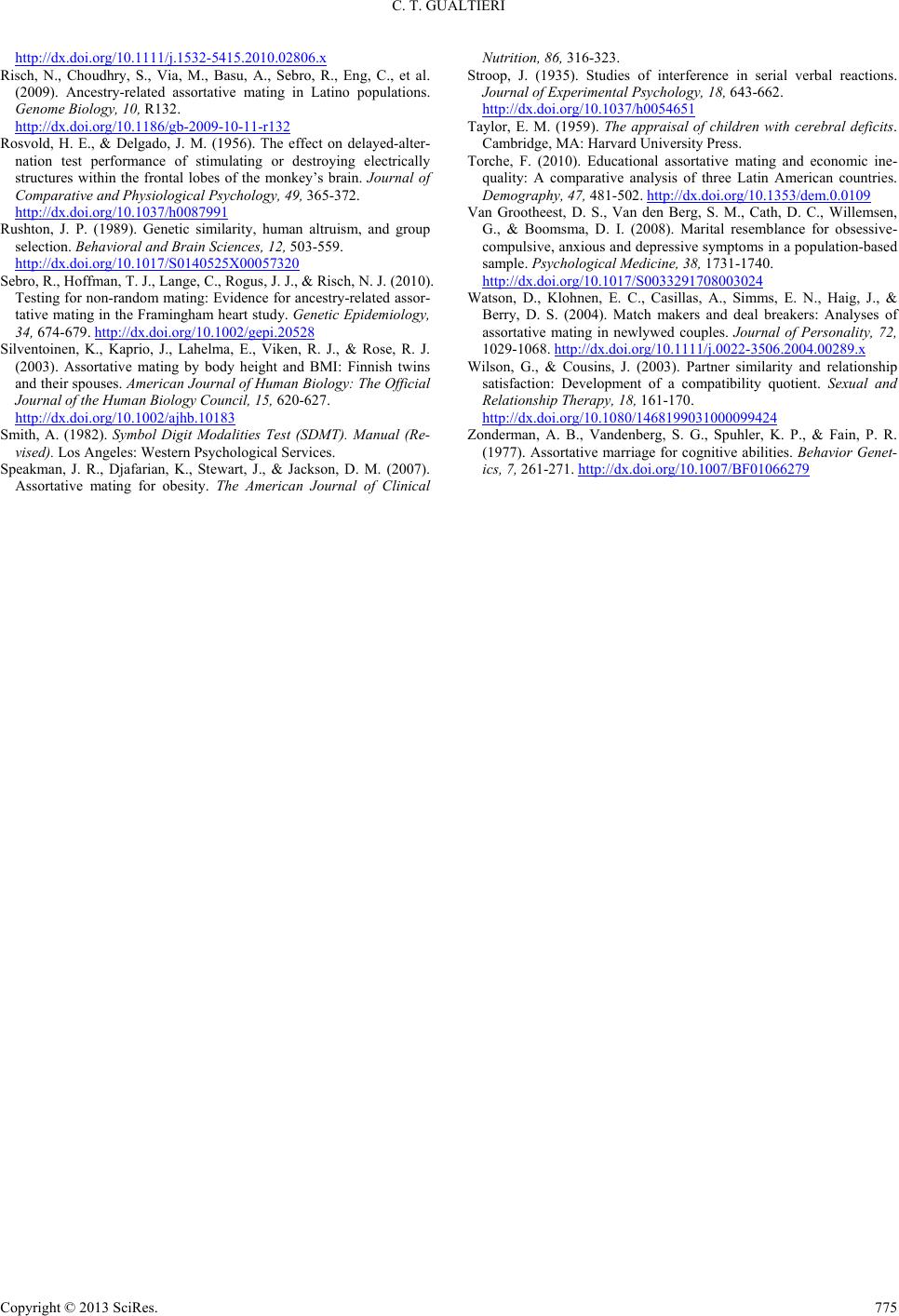 C. T. GUALTIERI Copyright © 2013 SciRes. 775 http://dx.doi.org/10.1111/j.1532-5415.2010.02806.x Risch, N., Choudhry, S., Via, M., Basu, A., Sebro, R., Eng, C., et al. (2009). Ancestry-related assortative mating in Latino populations. Genome Biology, 10, R132. http://dx.doi.org/10.1186/gb-2009-10-11-r132 Rosvold, H. E., & Delgado, J. M. (1956). The effect on delayed-alter- nation test performance of stimulating or destroying electrically structures within the frontal lobes of the monkey’s brain. Journal of Comparative and Physiological Psychology, 49, 365-372. http://dx.doi.org/10.1037/h0087991 Rushton, J. P. (1989). Genetic similarity, human altruism, and group selection. Be hav ioral and Brain Sciences, 12, 503-559. http://dx.doi.org/10.1017/S0140525X00057320 Sebro, R., Hoffman, T. J., Lange, C., Rogus, J. J., & Risch, N. J. (2010). Testing for non-random mating: Evidence for ancestry-related assor- tative mating in the Framingham heart study. Genetic Epidemiology, 34, 674-679. http://dx.doi.org/10.1002/gepi.20528 Silventoinen, K., Kaprio, J., Lahelma, E., Viken, R. J., & Rose, R. J. (2003). Assortative mating by body height and BMI: Finnish twins and their spouses. American Journal of Human Biology: The Official Journal of the Human Biology Council, 15, 620-627. http://dx.doi.org/10.1002/ajhb.10183 Smith, A. (1982). Symbol Digit Modalities Test (SDMT). Manual (Re- vised). Los Angeles: Western Psychological Services. Speakman, J. R., Djafarian, K., Stewart, J., & Jackson, D. M. (2007). Assortative mating for obesity. The American Journal of Clinical Nutrition, 86, 316-323. Stroop, J. (1935). Studies of interference in serial verbal reactions. Journal of Experimental Ps ych olog y, 18, 643-662. http://dx.doi.org/10.1037/h0054651 Taylor, E. M. (1959). The appraisal of children with cerebral deficits. Cambridge, MA: Harvard University Press. Torche, F. (2010). Educational assortative mating and economic ine- quality: A comparative analysis of three Latin American countries. Demography, 47, 481-502. http://dx.doi.org/10.1353/dem.0.0109 Van Grootheest, D. S., Van den Berg, S. M., Cath, D. C., Willemsen, G., & Boomsma, D. I. (2008). Marital resemblance for obsessive- compulsive, anxious and depressive symptoms in a population-based sample. Psychological Medicine, 38, 1731-1740. http://dx.doi.org/10.1017/S0033291708003024 Watson, D., Klohnen, E. C., Casillas, A., Simms, E. N., Haig, J., & Berry, D. S. (2004). Match makers and deal breakers: Analyses of assortative mating in newlywed couples. Journal of Personality, 72, 1029-1068. http://dx.doi.org/10.1111/j.0022-3506.2004.00289.x Wilson, G., & Cousins, J. (2003). Partner similarity and relationship satisfaction: Development of a compatibility quotient. Sexual and Relationship Therapy, 18, 161-170. http://dx.doi.org/10.1080/1468199031000099424 Zonderman, A. B., Vandenberg, S. G., Spuhler, K. P., & Fain, P. R. (1977). Assortative marriage for cognitive abilities. Behavior Genet- ics, 7, 261-271. http://dx.doi.org/10.1007/BF01066279
|